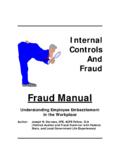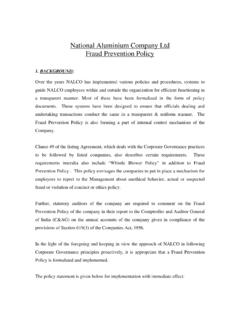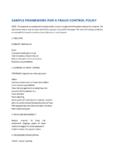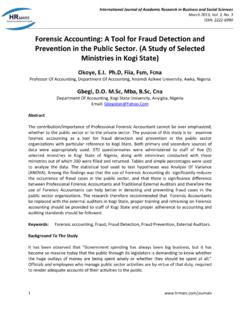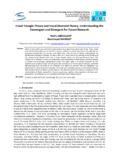Transcription of Internal auditing and fraud - Kingston City Group
1 IPPF Practice GuideInternal auditing and FraudDecember 2009 IPPF Practice Guidetable of ContentsIntroduction ..1 Executive Summary ..2 Definition of fraud ..4 fraud Awareness ..5A. Reasons for fraud ..5B. Examples of fraud ..7C. Potential fraud Indicators ..8 Typical Roles & Responsibilities for fraud ..10 Internal Audit Responsibilities During Audit Engagement ..13A. Conducting Audit Engagements ..13B. Internal Auditor Skepticism ..13C. Communicating With the Board ..14 fraud Risk Assessment ..16A. Identifying Relevant fraud Risk Factors ..16B. Identifying Potential fraud Schemes and Prioritizing Them Based on Risk ..17C. Mapping Existing Controls to Potential fraud Schemes and Identifying Gaps ..17D. Testing Operating Effectiveness of fraud Prevention and Detection Controls ..17E. Documenting and Reporting on the fraud Risk Prevention and Detection.
2 19A. fraud Prevention ..19B. fraud fraud Detection ..21 fraud Investigation ..23A. Investigation Process ..23B. Internal auditing s Role in Investigations ..23C. Conducting the Investigation ..24D. Reporting fraud Investigations ..25E. Resolution of fraud Incidents ..26F. Communications of fraud Incidents ..26G. Analysis of Lessons Learned ..27 Forming an Opinion on Internal Controls Related to fraud ..29 Appendix A Reference B Questions To Consider ..32 Appendix C fraud Risk Assessment Template ..33 IPPF Practice Guide / 1 IIA Standard 2060: Reporting to Senior Management and the BoardThe chief audit executive (CAE) must report periodically to senior management and the board on the Internal audit activity s purpose, authority, responsibility, and perfor-mance relative to its plan. Reporting must also include significant risk exposures and control issues, including fraud risks, governance issues, and other matters needed or requested by senior management and the Standard 2120: Risk The Internal audit activity must evaluate the potential for the occurrence of fraud and how the organi-zation manages fraud Standard 2210: Engagement Internal auditors must consider the probabil-ity of significant errors, fraud , noncompliance, and other exposures when developing the engagement addition, see Appendix A Reference Material which lists IPPF Practice Advisories that discuss fraud .
3 IntroductionThe purpose of this Practice Guide is to increase the Internal auditor s awareness of fraud and provide guidance on how to address fraud risks on Internal audit International Professional Practices Framework (IPPF) outlines the following International Standards for the Professional Practice of Internal auditing (Standards) pertaining to fraud and the Internal auditor s role in detect-ing, preventing, and monitoring fraud risks and addressing those risks in audits and Standard 1200: Proficiency and Due Professional Internal auditors must have sufficient knowl-edge to evaluate the risk of fraud and the manner in which it is managed by the organization, but are not expected to have the expertise of a person whose primary responsibil-ity is detecting and investigating Standard 1220: Due Professional Internal auditors must exercise due professional care by considering the:Extent of work needed to achieve the engagement s complexity, materiality, or significance of matters to which assurance procedures are and effectiveness of governance, risk management, and control of significant errors, fraud , or non- of assurance in relation to potential benefits.
4 Internal auditing and Fraud2 / The Institute of Internal AuditorsOngoing reviews an Internal audit activity that considers fraud risk in every audit and performs appropriate procedures based on fraud and detection efforts taken to reduce opportunities for fraud to occur and persuading individuals not to commit fraud because of the likelihood of detection and procedures and resources to fully investigate and report a suspected fraud effective Internal audit activity can be extremely help-ful in addressing fraud . Although management and the board are ultimately responsible for fraud deterrence, Internal auditors can assist management by determining whether the organization has adequate Internal controls and fosters an adequate control are various approaches that the CAE may use in con-sidering fraud while conducting Internal audit activities: auditing management controls over fraud .
5 This includes policies, awareness practices, tone at the top, board and senior management governance (the control environment), as well as related practices, such as risk assessment, assessing the adequacy of preventive and detected controls in managing fraud risk within organizational tolerances, incident management, investigations, and recovery prac-tices. Internal auditing should allocate resources to fraud -related activities in line with the risk of fraud relative to other organizational risks. auditing to detect likely fraud by testing high- risk processes, with the intention of looking for indicators of fraud , within the organization and with external business relationships. For example, testing payroll for phantom employees, or test-ing vendor invoices for overcharges, matching vendor addresses with employee addresses to executive SummaryFraud negatively impacts organizations in many ways including financial, reputation, psychological and social implications.
6 According to various surveys, monetary losses from fraud are significant. However, the full cost of fraud is immeasurable in terms of time, productivity, and reputation including customer relationships. Depending on the severity of the loss, organizations can be irrepa-rably harmed due to the financial impact of fraud activity. Therefore, it is important for organizations to have a strong fraud program that includes awareness, prevention, and detection programs, as well as a fraud risk assessment process to identify fraud risks within the organization. Frauds can be committed by an employee at any level within an organization, as well as by those outside the organization. There are three common characteristics of most frauds: Pressure or incentive the need the fraudster is trying to satisfy by committing the the fraudster s ability to commit the the fraudster s ability to justify the fraud in his or her mind.
7 An effective fraud management program includes:Company ethics policy tone at the top from senior management. fraud awareness understanding the nature, causes, and characteristics of risk assessment evaluating the risk of various types of Practice Guide / 3detect fictitious vendors, or reviewing databases for duplicate transactions. Considering fraud as part of every audit. For exam- ple, brainstorming about fraud risk, evaluating fraud controls, designing procedures that consider the fraud risk, or evaluating errors to determine whether they could be an indication of fraud . The cumulative results may provide perspective on whether management s awareness and risk man-agement programs have been implemented effec-tively across the organization. Consulting assignments help management iden- tify and assess risk and determine the adequacy of the control environment for process reviews, new business ventures, or IT applications.
8 Facilitation of management s self-assessment is another exam-ple of evaluating fraud risk, ensuring controls are in place to mitigate those risks, and who is moni-toring document will discuss fraud and provide general guidance to help Internal auditors comply with profes-sional Standards. To learn more about detecting and con-trolling fraud , see Appendix A Reference auditing and Fraud4 / The Institute of Internal Auditorsdefinition of fraud fraud encompasses a wide range of irregularities and illegal acts characterized by intentional deception or misrepre-sentation. The Institute of Internal Auditors (IIA s) IPPF defines fraud as: Any illegal act characterized by deceit, concealment, or violation of trust. These acts are not dependent upon the threat of violence or physical force. Frauds are per-petrated by parties and organizations to obtain money, property, or services; to avoid payment or loss of ser-vices; or to secure personal or business advantage.
9 Another definition of fraud from the publication Managing the Business Risk of fraud : A Practical Guide, sponsored by The IIA, the American Institute of Certified Public Accountants, and the Association of Certified fraud Examiners, states: fraud is any intentional act or omission designed to deceive others, resulting in the victim suffering a loss and/or the perpetrator achieving a gain. Frauds are characterized by intentional deception or mis-representation. This practice guide may refer to certain actions as fraud , which may also be legally defined and/or commonly known as Practice Guide / 5 fraud can range from minor employee theft and unpro-ductive behavior to misappropriation of assets, fraudulent financial reporting, or Ponzi schemes used to defraud inves-tors. However, the risk of fraud can be reduced through a combination of prevention, detection, and deterrence measures.
10 Most fraudulent schemes can be avoided with basic Internal controls and effective audits and oversight. Unfortunately, fraud can be difficult to detect because it often involves concealment through falsification of docu-ments or collusion among members of management, employees, or third-parties. A. Reasons for FraudMost frauds begin small and continue to grow as the scheme remains undetected. For example, perpetrators often view initial stealing as temporary borrowings that will be fixed before anyone notices the problem. The bor-rowing accelerates and the perpetrators take positions that are indefensible or develop a scheme for the concealment and attempt to avoid discovery. As the fraud continues to grow, hopefully, it will be detected by a fellow employee, management, or an Internal or external primarily exploit inadequate Internal controls for their own gain, resulting in substantial damage to the organization.
